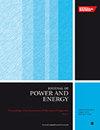Investigation of non-axisymmetric endwall contouring in a high loaded turbine stator cascade
IF 1.1
4区 工程技术
Q3 ENGINEERING, MECHANICAL
Proceedings of the Institution of Mechanical Engineers, Part A: Journal of Power and Energy
Pub Date : 2024-02-23
DOI:10.1177/09576509241235977
引用次数: 0
Abstract
The intensity and structure of the secondary flows have significant influences on the turbine cascade losses. Combining with the extension method of Non-linear Programming by Quadratic Lagrangian (NLPQLP), two endwall parametric methods respectively based on the B-spline surface and Fourier series are used to optimize the aerodynamic losses of a turbine cascade. The optimization processes are based on Computational Fluid Dynamics (CFD) analysis and two final designs are obtained by different methods. The endwall profile generated by the B-spline surface method (EW-B1) appears to relatively reduce the total pressure loss by 16.58% and the secondary kinetic energy coefficient ( C高负荷涡轮定子级联中的非轴对称端壁轮廓研究
二次流的强度和结构对水轮机级联损失有重大影响。结合二次拉格朗日非线性编程(NLPQLP)的扩展方法,分别采用基于 B 样条曲面和傅里叶级数的两种端壁参数方法来优化涡轮机级联的气动损失。优化过程以计算流体动力学(CFD)分析为基础,并通过不同的方法获得了两种最终设计方案。用 B-样条曲面法生成的端壁轮廓(EW-B1)似乎相对减少了 16.58% 的总压力损失和 27.08% 的二次动能系数(C SKE),而用傅里叶级数法生成的端壁轮廓(EW-F1)相对减少了 16.18% 的损失,但增加了 8.99% 的 C SKE。上部通道涡(PV)的径向移动和马蹄涡(HVps)压力分支的减弱被证实是 EW-B1 损失减少的原因,而 PV 的移动是 EW-F1 减少总压力损失的主要原因。在 EW-B1 中,HVps 的减弱对损失减少的影响更为显著,这是受漩涡轨迹上游的非轴对称形状和喉部附近 C SKE 生成量下降的影响。
本文章由计算机程序翻译,如有差异,请以英文原文为准。
求助全文
约1分钟内获得全文
求助全文
来源期刊

CiteScore
3.30
自引率
5.90%
发文量
114
审稿时长
5.4 months
期刊介绍:
The Journal of Power and Energy, Part A of the Proceedings of the Institution of Mechanical Engineers, is dedicated to publishing peer-reviewed papers of high scientific quality on all aspects of the technology of energy conversion systems.
 求助内容:
求助内容: 应助结果提醒方式:
应助结果提醒方式:


